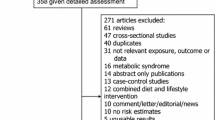Abstract
From observational studies to clinical trials in a variety of populations and age groups, evidence is mounting in support of the hypothesis that physical activity plays a significant role in the prevention of type 2 diabetes mellitus. Based on the current findings, it is likely that physical activity can reduce the risk of diabetes mellitus development. What is less clear is how much physical activity is necessary, and for how long.
Obviously, we are more likely to see the anticipated physiological changes if we maximise the dose. Yet, although maximal is better from a physiological point of view, we ‘in the trenches’ have also recognised the fact that a sedentary individual will most likely not continue to undergo a high intensity activity exercise regimen. In contrast, evidence is mounting regarding long term compliance to moderate levels of activity, which appear to be easier to adopt in one’s lifestyle and are less likely to result in injury. More importantly, there appear to be beneficial changes in insulin sensitivity and glucose tolerance in the sedentary individual who incorporates moderate levels of activity such as walking into the their lifestyle, although the onset of beneficial metabolic changes appear to occur much more slowly and less dramatically than what occurs with a high intensity regimen.
Even if activity is shown to be beneficial, we are faced with the challenge of reaching the sedentary individuals who would most likely benefit from an increase in physical activity in the first place. This task is a difficult one because of the difficulty in quantifying the sum total of an entire day’s worth of movement, rather than that of a few relatively higher intensity leisure activities. What is needed is a measure or combination of measures of physical activity that are simple to use, relatively inexpensive, and adequately capture the subtle changes in physical activity through the day that we are encouraging.
It is unlikely that the protective nature of a physically active lifestyle in preventing diabetes mellitus will have a lasting impact once a switch to a sedentary way of life is made. Therefore, from a public health viewpoint, long term commitments to increased activity are required. This is the ultimate challenge.
Similar content being viewed by others
References
Physical activity and health: a report of the Surgeon General. US Department of Health and Human Services. Centers for Disease Control and Prevention. National Center for Chronic Disease Prevention and Health Promotion. President’s Council on Physical Fitness and Sports, 1996
Eriksson KF, Lindgärde F. Prevention of type 2 (non-insulin-dependent) diabetes mellitus by diet and physical exercise. Diabetologia 1991; 34: 891–8
Pan X, Li G, Hu Y, et al. Effects of diet and exercise in preventing NIDDM in people with impaired glucose tolerance: the Da Qing IGT and diabetes study. Diabetes Care 1997; 20: 537–44
Ivy JL, Zderic TW, Fogt DL. The prevention and treatment of non-insulin-dependent diabetes mellitus. Exerc Sports Sci Rev 1999; 27: 1–35
Bouchard C. Individual differences in the response to regular exercise. Int J Obes 1995; 19: S5–8
Holloszy JO, Schultz J, Kusnierkiewicz J, et al. Effects of exercise on glucose tolerance and insulin resistance. Acta Med Scand 1986; Suppl. 711: 55–65
Schneider SH, Amorosa LF, Khachadurian AK, et al. Studies on the mechanism of improved glucose control during regular exercise in type 2 diabetes. Diabetologia 1984; 26: 355–60
Koivisto VA, Yki-Jarvinen H, DeFronzo RA. Physical training and insulin sensitivity. Diabetes Metab Rev 1986; 1: 445–81
Kriska A, LaPorte R, Pettitt D, et al. The association of physical activity with obesity, fat distribution and glucose intolerance in Pima Indians. Diabetologia 1993; 36: 863–9
Pate RR, Pratt M, Blair SN, et al. Physical activity and public health: recommendation from the Centers for Disease Control and Prevention and the American College of Sports Medicine. JAMA 1995; 273: 402–7
Pollock ML, Carroll JF, Graves JE, et al. Injuries and adherence to walk/jog and resistance training programs in the elderly. Med Sci Sports Exerc 1991; 23: 1194–200
Pereira MA, Kriska AM, Day RD, et al. A randomized walking trial in postmenopausal women: effects on physical activity and health 10 years later. Arch Intern Med 1998; 158: 1695–701
Björntorp P, Krotkiewski M. Exercise treatment in diabetes mellitus. Acta Med Scand 1985; 217: 3–7
Diabetes Prevention Program Research Group. The diabetes prevention program: design and methods for a clinical trial in the prevention of type 2 diabetes. Diabetes Care 1999; 22: 623–34
Kriska A, Knowler W, LaPorte R, et al. Development of a questionnaire to examine relationship of physical activity and diabetes in Pima Indians. Diabetes Care 1990; 13: 401–11
Yamanouchi K, Ozawa N, Shinozaki T, et al. Daily walking combined with diet therapy is a useful means for obese NIDDM patients not only to reduce body weight but also to improve insulin sensitivity. Diabetes Care 1995; 18: 775–84
Author information
Authors and Affiliations
Rights and permissions
About this article
Cite this article
Kriska, A. Physical Activity and the Prevention of Type 2 Diabetes Mellitus. Sports Med 29, 147–151 (2000). https://doi.org/10.2165/00007256-200029030-00001
Published:
Issue Date:
DOI: https://doi.org/10.2165/00007256-200029030-00001




